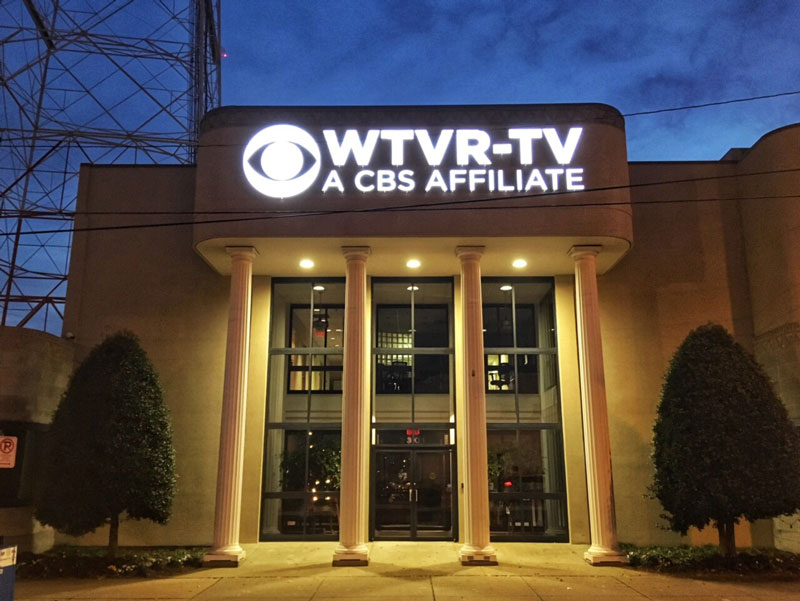Since the beginning, the foundation of the U.S. television system has been broadcasting the programs nationally, which ultimately led to the creation of an affiliate-TV model. With that model, a program developed by a central structure (or a studio) would be aired by several local TV stations. This model was developed to take advantage of both local ads (like from supermarkets and car dealers) and national sponsors (like Coca Cola).
From an initial five interconnected local TV stations in 1945 (with WNBT as the originator), by 1951 there were four different networks in operation. Today, 240 TV stations are affiliated with the ABC TV network (owned by Disney), of which eight are owned and operated (O&O) by ABC, while the rest are independently owned (mostly by station groups).
But while affiliation evolved because locally produced programs couldn’t attract national sponsors (mostly due to their poor quality and appeal), today, the local TV network affiliates depend on locally produced shows to attract advertisers since the networks reduced their content offerings in order to focus on their streaming services. However, the changing system revolving around the affiliate relations business model doesn’t concern just programming, but also the financial arrangements between the networks and their affiliates.
What is interesting about this aspect is that few executives, analysts, consultants, trade associations, and reporters are actually familiar with the nuts and bolts of how the relationship actually works.
The Washington, D.C.-based National Association of Broadcasters (NAB), for example, sent us a link to a historical book (Stay Tuned, by Christopher H. Sterling and John M. Kittross) instead of answering a few questions on the matter, perhaps thinking that the book could help. That book, like other TV books VideoAge consulted, did not even cover affiliate relations. However, before the pandemic the NAB show in Las Vegas used to have affiliate board of directors’ meetings. These meetings resumed in 2023 and were attended by reps from the ABC, CBS, FOX, and NBC TV networks. That year marked the 13th year in which the affiliate boards have met in conjunction with the NAB Show.
When asked about the changed business model of network TV affiliation, one former executive of a local TV station group who was touted as an expert in the field, replied: “You’re onto a good topic here [but] I’m not currently best suited for this discussion.” Another former executive of a TV station in a major market said that he “was [just] the CEO, ” implying that he was unfamiliar with affiliate business. A similar answer came from a former TV network executive, who said that he wasn’t qualified to comment. An executive currently in charge of affiliate relations at a major TV station group, simply replied: “No comment from me.”
One top TV consultant who wanted to remain anonymous put it all in context with a suggestion: “This is a challenging subject and broadcast groups are very reluctant to provide any info.”
Finally, no reps from TV networks wanted to comment on the record, with one anonymous FOX executive just saying, “The FOX Broadcast Distribution and Marketing team oversees 209 primary affiliates in DMAs across the country.”
DMA, or Designated Market Area, is the way Nielsen ranks the 210 U.S. TV regions. It is also called Television Market Area. Former rating service Arbitron used the term “Area of Dominant Influence” (or ADI).
All of this reluctance is understandable since the networks’ affiliate divisions are as convoluted as their operations, which include “Station Relations,” “Affiliate Operations, ” the related “Legal” departments, plus dealings with Affiliate Boards of Directors, and Television Affiliate Associations.
Each affiliate group (for ABC, NBC, FOX, CBS and The CW) has a board that is selected by the affiliates and represents the affiliates in discussions with the networks on a variety of issues concerning programming, inventory, news, sports, and digital. The boards usually have representatives from the larger groups (e.g. Nexstar, Sinclair, Tegna, etc.), but also have individual station GMs sitting on their boards.
Each affiliate group has varying numbers of members based on their bylaws, so likely around eight-to-10 members. Board members are elected by vote of the entire affiliate body once a year, usually for three-year terms.
In addition, each affiliate group has its own affiliate association that is comprised of all stations affiliated with the particular network in question. There is not a single Television Affiliates Association.
The FCC, the U.S. government communications regulator, also got into the affiliate picture when Westinghouse Broadcasting, which had stations affiliated with each of the three networks, filed a petition with the FCC in 1976 asking for an investigation of affiliate compensation that pushed the FCC to institute an Office of Network Study Special Staff in 1978.
In effect, the affiliate relation divisions of the networks are at the core of the U.S. network systems, and separate from the programming side (which is more linked to airtime sales and production divisions), and the recent possibility that Disney could sell the owned and operated (O&O) local TV stations of its ABC network, but retain the programming division, highlighted a business model that is now reaching its third level of development.
The first level of this evolution can be considered the business model that started in 1952 when the television sector exploded from 108 local TV stations to 440 in 1960 and 530 in 1965. In that era, local TV stations were revered by the affiliated network, and amply compensated with cash for their airtime that was given to network programming. In addition, the networks gave local affiliates “avails” or “inventory” (a few airtime minutes) within the network programming for local ad sales.
Local stations had rate cards for local sales and national sales. These later ones were handled by TV rep firms what would deal with national advertisers who, for example, wanted to reach only the top 20 TV markets (the U.S. is divided in 210 TV markets, with the New York City area being the number 1 market). Under this arrangement, local TV stations became very profitable and even more rewarding with the introduction of “fin-syn” and “prime access” rules in 1970, which created a U.S. syndication market for popular off-network shows and limited the early evening networks’ programming to local TV stations. Earlier, the networks provided affiliates with morning, afternoon, and evening programming (about 60 percent of their schedules).
The second level of this network-affiliate evolution started when station groups began buying local stations because they were generating lots of cash. In order to increase profits they triggered cost reduction that affected local programming, causing lower ratings.
In 1995, Disney acquired ABC for $19 billion, which included the network, ABC’s eight O&O local TV stations, and the affiliate-relation contracts.
CBS also owns eight local TV stations in top TV markets that include Miami and Atlanta. Viacom merged with CBS first in 1999 in a deal valued at $35 billion. In 2006, the two companies split, then merged again in 2019 in a deal valued at $15.4 billion.
Today, Wells Fargo Bank analyst Steven Cahall valued ABC and Disney’s eight owned affiliate networks at about $4.5 billion.
During this “devolution,” U.S. consumers began to cancel cable and satellite TV subscriptions. This “cord-cutting” meant less affiliate revenue in terms of “retrans” fees for local TV station programming and network shows. Cable-satellite TV subs now account for 56 percent of total TVHH (out of 131.5 million).
Before the station groups got into the picture, local TV was in the driver’s seat vis-a-vis the networks. This power peaked in the mid-1990s when FOX was “stealing” affiliates. John McMorrow of Locality (formerly Cox Media Group) explained that, “Before mid-2000s there was a shift of power back to the networks in markets where their affiliate had nowhere else to go. This reversal eventually morphed into an actual reversal of compensation. This was especially true in markets where there was a viable indie or another station that was seeking an affiliation.”
And this takes the U.S. TV sector to the third and current evolution of the affiliate-relation business model where the network makes demands for such things as “Pre-emption Reimbursement,” (because in the past local TV stations could decide which network shows they could preempt for, for example, a major local sports event).
An affiliate agreement between ABC and the local stations of Hearst-Argyle reviewed by VideoAge indicated 2005 as the start of “Reverse Compensation” (RC), however, Rick Feldman, a former broadcaster and onetime president of NATPE when it was a TV association, reported, “I left KCOP in 2000. And it was just about then that RC was bubbling.”
According to a former TV station group CEO who wants to remain anonymous, “Reverse comp was phased in with each station or group based on their individual contracts with each network. I believe it began around the mid to late 2000s and likely all affiliates were paying the networks for their affiliations by approximately 2012-2015. Again, it would have depended on individual contracts, which vary in length from likely about five years to as many as 10 back then. Currently, most of the deals are much shorter, probably around three years.”
An ABC agreement with WSET-TV (Lynchburg, Virginia) as a “Primary Affiliate” for the 2013-2017 period, indicated rules for “regularly scheduled programs,” “preemption reimbursement” (at 100 percent for primetime to 15 percent for daytime), and even “broadcast standards” to adhere to.
As for the “local inventory level for local sales” within the network programming, the agreement set it at 50 minutes and 15 seconds per week. As for compensation, the agreement stated that the station would pay an annual fee (“payable in monthly installments”), plus retrans fee (paid by cable operators to local TV stations) for the network-programming portion.
One question that VideoAge was not able to clarify was the term “Primary Affiliate,” seen in the agreement between ABC and WSET-TV. “I do not know what you mean by primary affiliate,” reported a former station group executive. “There are a few smaller markets where there are stations with dual affiliations (e.g. CBS/FOX or ABC/NBC), so perhaps there is one that is considered primary? I am not sure. Most stations only have one affiliation,” the exec concluded.
After the advent of the station groups, another Wall Street-driven paradigm hit corporate TV executives wanting to eliminate the middlemen (which, in this case was represented by the affiliate TV station and ad agencies) by going directly to the consumer with their streaming services, and in the process negatively affecting the affiliates with the networks’ promotion of their own streaming services using the strength of the affiliates’ local TV coverage, and by the networks posting their new network content on their own streaming services, and thus competing with the affiliates.
Nonetheless, local TV stations continue to generate income to TV networks, with each viewer worth an estimated $0.23 per hour to the network in ad revenue.
(By Dom Serafini)
Audio Version (a DV Works service)










Leave A Comment